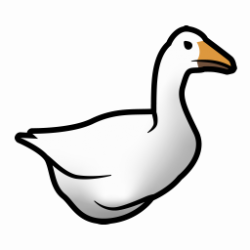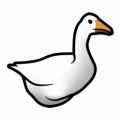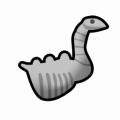Difference between revisions of "Goose"
(gallery) |
|||
| Line 49: | Line 49: | ||
A '''Goose''' is a domesticated, medium-sized waterfowl, known for its large eggs and belligerent nature. Like all farm animals geese cannot be found in the wild, and must be purchased from traders. | A '''Goose''' is a domesticated, medium-sized waterfowl, known for its large eggs and belligerent nature. Like all farm animals geese cannot be found in the wild, and must be purchased from traders. | ||
| − | ==Summary== | + | == Summary == |
| − | Geese | + | {{Pen Animal Note|Geese}} |
| − | + | A female goose produces {{P|Eggs Per Clutch Average}} [[ostrich egg]] every {{P|Egg Laying Interval}} days. Geese can lay both [[Chicken egg (unfert.)|unfertilized]] and [[Chicken egg (fert.)|fertilized]] eggs, depending on if it has mated with a male goose. | |
| − | + | == Analysis == | |
| − | == | + | ===Eggs=== |
| − | + | An adult goose consumes {{P|Real Hunger Rate}} nutrition per day, and produces {{#vardefineecho:egg_nutr_per_day|{{#expr:{{P|Eggs Per Clutch Average}}/{{P|Egg Laying Interval}}*{{Q|Goose egg (unfert.)|Nutrition}}}}}} nutrition of eggs each day, resulting in a nutrition efficiency of {{#expr:{{#var:egg_nutr_per_day}}/({{P|Base Hunger Rate}}*1.6) round 3}} when unfertilized eggs are eaten. | |
| − | |||
| − | + | Geese are inferior to [[chicken]]s. | |
| − | |||
| − | |||
| − | + | ===Meat=== | |
| + | A goose yields {{#vardefineecho:baby_leather|{{Meat Leather Curve|{{#expr:{{P|Body Size}}*0.1*36}}}}}} leather as a gosling; {{Meat Leather Curve|{{#expr:{{P|Body Size}}*0.5*36}}}} as a juvenile; or {{Meat Leather Curve|{{#expr:{{P|Body Size}}*36}}}} as an adult. | ||
| − | + | By slaughtering the geese rather than eating the unhatched [[Goose egg (fert.)|fertilized egg]], more nutrition is gained ({{#expr:{{#var:baby_meat}}*0.05 round 2}} rather than {{Q|Goose egg (fert.)|Nutrition}}). | |
| − | As a gosling grows into adulthood it will consume {{#expr:{{Consumption Upto Adulthood}} round 2}} nutrition in total, and will yield {{#expr:0.05*({{P|Meat Yield}} - {{#var:baby_meat}})}} more nutrition when slaughtered than it would as a baby. This means that the nutrition efficiency of a growing gosling is {{#expr:0.05*({{P|Meat Yield}} - {{#var:baby_meat}})/{{Consumption Upto Adulthood}} round 3}}. | + | When new-born goslings are slaughtered, an always-fertilized female goose produces {{#expr:{{Meat Production|{{PAGENAME}}|Baby}} round 2}} nutrition per day, resulting in a nutrition efficiency of {{#expr:{{Meat Production|{{PAGENAME}}|Baby}}/({{P|Base Hunger Rate}}*1.6) round 3}} for the female goose alone. |
| + | |||
| + | A {{#vardefineecho:femaleratio|{{#expr: 2/3*24*{{P|Egg Laying Interval}}/{{P|Mate Mtb Hours}}}}}}:1 female:male ratio reaches an optimal [[Animals#Mating|fertilization rate]]. With this ratio of geese, you reach a nutrition efficiency of {{%|{{Meat Production|{{PAGENAME}}|Baby|{{#var:femaleratio}}|1 round 2}}}}}}/{{Nutrition Consumption|{{PAGENAME}}|Baby|{{#var:femaleratio}}|1}} round 3}}. | ||
| + | |||
| + | A goose takes {{#expr:{{P|Juvenile Age}}*60 round 1}} days to become a juvenile, and a total of {{#expr:{{P|Maturity Age}}*60 round 1}} days to reach adulthood. As a gosling grows into adulthood it will consume {{#expr:{{Consumption Upto Adulthood}} round 2}} nutrition in total, and will yield {{#expr:0.05*({{P|Meat Yield}} - {{#var:baby_meat}})}} more nutrition when slaughtered than it would as a baby. This means that the nutrition efficiency of a growing gosling is {{#expr:0.05*({{P|Meat Yield}} - {{#var:baby_meat}})/{{Consumption Upto Adulthood}} round 3}}. | ||
==Training== | ==Training== | ||
Revision as of 06:31, 28 February 2023
Goose
A domesticated bird kept by humans as poultry for it's eggs and meat. Lays eggs very often, however they take a long time to hatch.
Base Stats
- Type
- Animal
- Flammability
- 70%
Pawn Stats
- Move Speed
- 2.3 c/s
- Health Scale
- 0.4
- Body Size
- 0.6
- Mass - Baby
- 3.6 kg
- Mass - Juvenile
- 18 kg
- Mass - Adult
- 36 kg
- Carrying Capacity
- 45 kg
- Filth Rate
- 6
- Hunger Rate
- 0.45 Nutrition/Day
- Diet
- herbivorous
- Life Expectancy
- 8 years
- Manhunter Chance
- 0%
- Manhunter Chance (Taming)
- 0%
- Trainable Intelligence
- None
- Wildness
- 60%
- Minimum Handling Skill
- 5
- Roam Interval
- 7 days
- Mate Interval
- 8 hours
- Maturity Age
- 0.2 years (12 days)
- Juvenile Age
- 0.12 years (7.2 days)
- Comfortable Temp Range
- -10 °C – 40 °C (14 °F – 104 °F)
Production
- Meat Yield
- 84 bird meat
- Leather Yield
- 26 birdskin
- Eggs Per Clutch
- 1 to 1
- Egg Laying Interval
- 2 days
- Can Lay Unfertilized Eggs
- true
Melee Combat
- Attack 1
- Feet
3 dmg (Scratch)
4 % AP
1.5 second cooldown - Attack 2
- Beak
5.6 dmg (Bite)
8 % AP
2 second cooldown - Attack 3
- Head
2 dmg (Blunt)
3 % AP
1.5 second cooldown
0.2 chance factor - Average DPS
- 1.27
- tradeTags
- AnimalFarm, AnimalCommon
A Goose is a domesticated, medium-sized waterfowl, known for its large eggs and belligerent nature. Like all farm animals geese cannot be found in the wild, and must be purchased from traders.
Summary
Geese are pen animals. Once tamed, pen animals cannot and do not need to be trained any further. But if left outside of a pen or caravan hitching spot, pen animals will eventually roam outside your colony. Making a caravan is not required to tie animals to a caravan hitching spot.
A female goose produces 1 ostrich egg every 2 days. Geese can lay both unfertilized and fertilized eggs, depending on if it has mated with a male goose.
Analysis
Eggs
An adult goose consumes 0.45 nutrition per day, and produces 0.25 nutrition of eggs each day, resulting in a nutrition efficiency of 0.558 when unfertilized eggs are eaten.
Geese are inferior to chickens.
Meat
A goose yields 6 leather as a gosling; 18 as a juvenile; or 26 as an adult.
By slaughtering the geese rather than eating the unhatched fertilized egg, more nutrition is gained (Expression error: Unexpected * operator. rather than 0.5).
When new-born goslings are slaughtered, an always-fertilized female goose produces 0.43 nutrition per day, resulting in a nutrition efficiency of 0.949 for the female goose alone.
A 4:1 female:male ratio reaches an optimal fertilization rate. With this ratio of geese, you reach a nutrition efficiency of 170%}}/ 2.24
round 3}}.
A goose takes 7.2 days to become a juvenile, and a total of 12 days to reach adulthood. As a gosling grows into adulthood it will consume 2.9 nutrition in total, and will yield 3.35 more nutrition when slaughtered than it would as a baby. This means that the nutrition efficiency of a growing gosling is 1.154.
Training
This animal can be trained as follows:
| Guard: | |
|---|---|
| Attack: | |
| Rescue: | |
| Haul: | |
*As of version 1.1.2610, all animals can be tamed. The percentage of likelihood of success depends on factors such as the Animals Wildness Percentage, Pawn Handling Skill, and others. More information can be found on the animals page.
Health
Gallery
Version history
- 1.1.0 - Added as part of the integration of the Vanilla Animals Expanded - Livestock mod into the basegame.




